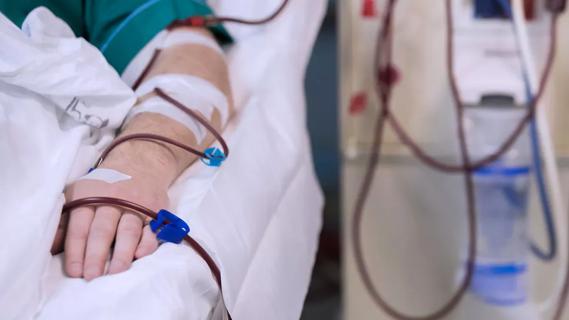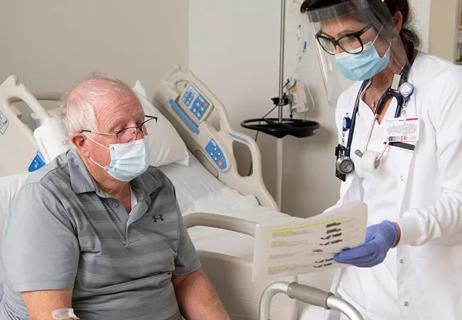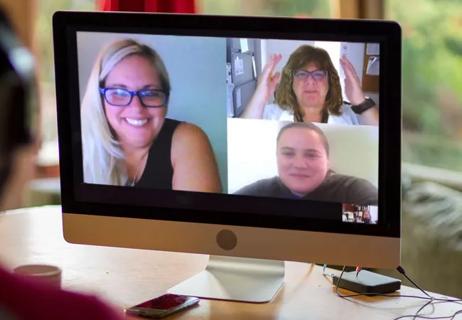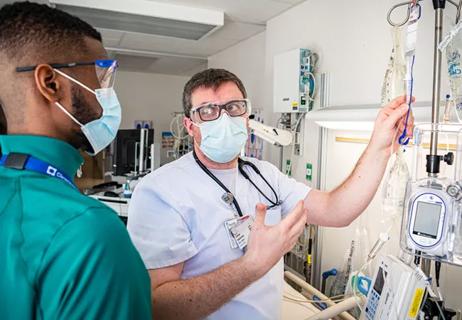Lean approach on med-surgical unit leads to lasting changes

Nurses on a medical-surgical unit at Cleveland Clinic’s Hillcrest Hospital recently implemented a simple, cost saving idea. “A lot of staff used scissors from suture kits to open medications or lidocaine patches,” says Krissy Cochrane, BSN, RN, CMSRN, assistant nurse manager. “Kits were opened every day just for a pair of scissors.” That left a lot of unused items, from tissue forceps to gauze. So the medical-surgical unit purchased three pairs of scissors and chained one pair at each nurses’ station.
Cleveland Clinic is a non-profit academic medical center. Advertising on our site helps support our mission. We do not endorse non-Cleveland Clinic products or services. Policy
The idea is one of many that have been carried out on the unit as part of a continuous improvement (CI) initiative that began in June 2014. The goal is to engage all of the unit’s 115 caregivers in better delivery of safe, affordable patient care by utilizing the lean approach* to improve processes, eliminate waste and standardize operating procedures.
“Lean gives caregivers a structured approach to problem solving that improves the quality and safety of our patient care,” says Susan Coyne, BSN, RN, the CI embed from Cleveland Clinic’s Zielony Nursing Institute. “It focuses on frontline staff coming up with solutions. Then leadership helps to remove barriers and provide support and time for problem-solving.”
The unit began the initiative last year with the support of a multidisciplinary team led by CI and the unit’s shared governance co-leaders. Coyne and Melissa Vandergriff, CI Director for Hillcrest Hospital, used the following improvement model as a road map to guide the process.
Organizational Alignment Identify and communicate what matters most.
Visual Management Reinforce what matters most and enable the entire team to participate. Visually track performance of key metrics.
Problem-solving Identify problems and resolve them as a team.
Standardization Develop standards and become disciplined in following them.
“Nursing has an advantage over other areas at Cleveland Clinic in implementing continuous improvement,” says Coyne. “Nursing staff are natural problem solvers, and we already brought our Professional Practice Model (PPM) to life by featuring the model on dry-erase boards.” The boards are divided into four guiding principles of the Nursing Institute’s PPM: quality and patient safety, professional development and education, research and evidence-based practice, and healing environment. Nurse managers add key points to the appropriate quadrant.
“These boards are used when discussing key activities in nursing huddles, and have become a great tool for visual management,” Coyne adds.
During the first couple of months, Coyne and Vandergriff coached nurses on improving huddles, using the PPM boards as they were intended. Next, they and the nurse manager asked staff three key questions: What matters most to them? What makes a good day on the unit? What makes a bad day?
Those things that make a bad day — about a dozen were identified — were barriers to improvement. Nurses collected data (or metrics) on the barriers to learn why they occurred and to assist in their search for solutions. “Once we obtained metrics, we talked about the barriers twice a day at huddles as part of our visual management approach,” says Matthew Drew, MS, BSN, RN, NE-BC, nurse manager for the unit. To learn the principles of lean, members of the shared governance committee also watched CI videos, including one on “8 Forms of Waste” that helps people identify inefficiencies that lead to waste.
In addition, the team has designated a unit break room as the “Improvatorium,” where they set up a visual management tool to share, discuss and track their ideas. Ideas are written on color-coded cards based on their level of complexity and are placed on the large whiteboard in the Improvatorium. They are then moved along the board to indicate where the idea stands — if it’s been submitted, approved, worked on or standardized.
One area of concern that the unit addressed was staff responsiveness. “The time it takes nurses to get to patients [who push the call light] decreased from one minute and 40 seconds before we started addressing the issue to as low as 48 seconds,” says Cochrane. After tracking metrics related to responsiveness, staff nurses on the unit narrowed it down to three primary areas causing delays: the admission process, staffing and scheduling, and the call light system. They then identified and devised the following countermeasures:
The Admission Process Caregivers are alerted when a new patient is en route to the unit to ensure the room is properly set up. Upon arrival, patients are introduced to their caregivers and given a welcome letter. Nurses use an admission checklist to make sure they complete all necessary tasks.
Staffing and Scheduling Patient assignments now take into consideration the acuity of patients, so one nurse doesn’t have an abundance of very sick patients and another has less acute patients. In addition, nurses are assigned “buddies”: If one nurse is busy with one patient, the buddy can respond to other patients.
The Call Light System The unit eliminated its call center and now utilizes technology to the fullest. “The call now goes directly to the nurses and nursing aides through Vocera® [the voice communication system],” says Coyne. “Whoever is available gets to the call first.”
These changes, which are now incorporated into the unit’s standard operating procedures, worked to enhance team collaboration and communication that affected patient outcomes: The unit achieved 96th percentile in a recent HCAHPS (Hospital Consumer Assessment of Healthcare Providers and Systems) patient survey “Nursing Communication” domain and 83rd percentile in the “Responsiveness” domain.
But the CI initiative isn’t a “one-and-done” program that ended when the first barriers were addressed. The unit has recently begun working on inventory waste. “We are looking at simple efficiencies now,” says Drew. “Yes, there are going to be some large-scale changes, but what’s really made the project successful is the summation of a bunch of small changes.”
The other key to success was a shift in culture, stated Drew and Cochrane. “As managers, we are so used to putting out fires. This initiative builds capability within our staff. It empowers them and gives them the tools to be successful,” says Drew. “That’s why it’s working. Nurses have psychological ownership of not only the ideas, but the overall process.”
*The lean approach was first developed by Toyota in 1990 and has spread to many industries.

Phone triage system reduces call backs and delays in care

New protocol reduces costs, increases patient and caregiver satisfaction

New options benefit caregivers, nursing units and patients

Nurses facilitate preoperative program to educate and prepare patients for ongoing care

Introduces at-home work and new patient screening tool

Health disparities, mental health and more

Ideas for approaches to prevention, response and more

Educating and developing generations of nurses